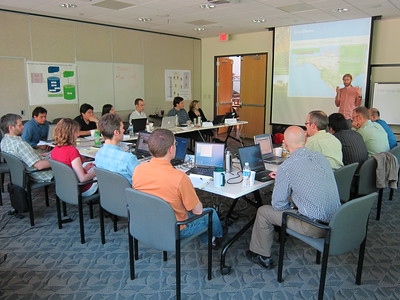
Greetings,
Before diving into journal articles, I want to highlight a blog, short video, and web map update. First, over the last several years of working in conservation, I hear more and more calls for conservation to rapidly scale effective solutions. Sometimes that's coupled with a sense of urgency that makes us think we don't have time for missteps or to do things that don't work. But this article makes a compelling case that if we want to scale fast, that means we will need a higher tolerance for the risk of failure. It's a good read! https://ssir.org/articles/entry/getting_honest_about_what_were_willing_to_risk_for_the_planet#
Want to know how (and why) to talk to "uncle Ernie" and other people who are not convinced we need to urgently act on climate change? Check out Dr. Katherine Hayhoe's interview on Jimmy Kimmel: https://youtu.be/LVjmGVufADk
The last quick update is for those of you working in South America. The latest update to Mapbiomas includes fire scars and water surface area: https://plataforma.brasil.mapbiomas.org/agua
They have cool graphs showing changes (drops) in water area over time. The (user's) accuracy is mostly 75% or above, but it's really low in the Pantanal (see https://mapbiomas.org/metodo-agua). They saw a huge drop there (74% less water over 30 years) but it's hard to know how much of that is real. Unfortunately the high variation throughout the year makes validating annual estimates of water surface inherently tricky.
If you know someone who wants to sign up to receive these summaries, they can do so at http://bit.ly/sciencejon
CLIMATE CHANGE:
Welsby et al. 2021 ask an interesting question: what fraction of economically viable fossil fuels need to left in the ground to give us a 50% shot at limiting warming to 1.5C? The answer is pretty stark: by 2050 we need to leave 58% of oil, 59% of methane gas, and 89% of coal underground (a 3% annual reduction in oil and gas). See table 1 for their estimates by region. They note that we may need to leave even more fuels unextracted given questions about how fast we can develop "negative emissions" technology (carbon capture and storage).
Zhang et al. 2020 finds that 3.7% of total natural gas (mostly methane) extracted in the Permian basin (west Texas and SE New Mexico) is lost via leaks (w/ 4.1% lost in the Delaware sub-basin). It's a cool study using a recent satellite to estimate methane emissions, and EDF is launching a more precise satellite for this in 2022. This is a big deal because given methane has ~84 times the impact of CO2 on global warming over the next 20 years (dropping after that). So this leakage rate means that right now natural gas from the Permian has more short-term climate impact than coal (see http://blogs.edf.org/energyexchange/2013/11/05/methane-a-key-to-dealing-with-carbon-pollution/)! The authors think the leaks in this region are mostly from venting and flaring during active production (as opposed to leaks after well abandonment)
MARINE PROTECTED AREAS:
Sala et al. 2021 identify global priorities to designate as marine protected areas (MPAs), with the goal of protecting biodiversity and carbon while improving the yield of fisheries. The yield improvements come from targeting areas that are currently both overexploited and unprotected; they find protecting 9% of the ocean could boost maximum sustainable yield (MSY) from seafood by about 10% (protecting 5% increases yield by ~9%, Fig 1d,). The authors recommend protecting 28% of the ocean (not 9%) but their data seem to indicate the food benefit is the same at both levels. Fig 3 has some other interesting scenarios, including giving equal weight to food and biodiversity (3c, leading to a recommendation to protect 45% of the ocean which provides 92% of maximum fisheries benefit, 71% of max. biodiversity benefit, and 29% of max carbon benefits) or maximizing biodiversity without harming production (3d, recommending to protect 71% of the ocean which provides neither fisheries benefit nor harm, 91% of max. biodiversity benefit, and 48% of max carbon benefits). The unequal distribution of priority areas (Fig 1 & 2) raise potential equity concerns that are not addressed. Also apparently the carbon estimates do not account for additional boat travel time and thus may be optimistic. Finally: I know very little about marine ecosystems so let me know if you think my summary is wrong.
UPDATE: Concerns have been raised about the model this paper is based on, and the earlier paper this builds on has been retracted primarily due to an undisclosed conflict of interest: https://sustainablefisheries-uw.org/flawed-mpa-science-retracted/
REFERENCES:
Sala, E., Mayorga, J., Bradley, D., Cabral, R. B., Atwood, T. B., Auber, A., Cheung, W., Costello, C., Ferretti, F., Friedlander, A. M., Gaines, S. D., Garilao, C., Goodell, W., Halpern, B. S., Hinson, A., Kaschner, K., Kesner-Reyes, K., Leprieur, F., McGowan, J., … Lubchenco, J. (2021). Protecting the global ocean for biodiversity, food and climate. Nature, 592(7856), E25–E25. https://doi.org/10.1038/s41586-021-03496-1
Welsby, D., Price, J., Pye, S., & Ekins, P. (2021). Unextractable fossil fuels in a 1.5 °C world. Nature, 597(7875), 230–234. https://doi.org/10.1038/s41586-021-03821-8
Sincerely,
Jon
p.s. the photo above is of me driving an excavator at Diggerland, which was quite fun albeit not the greenest activity

